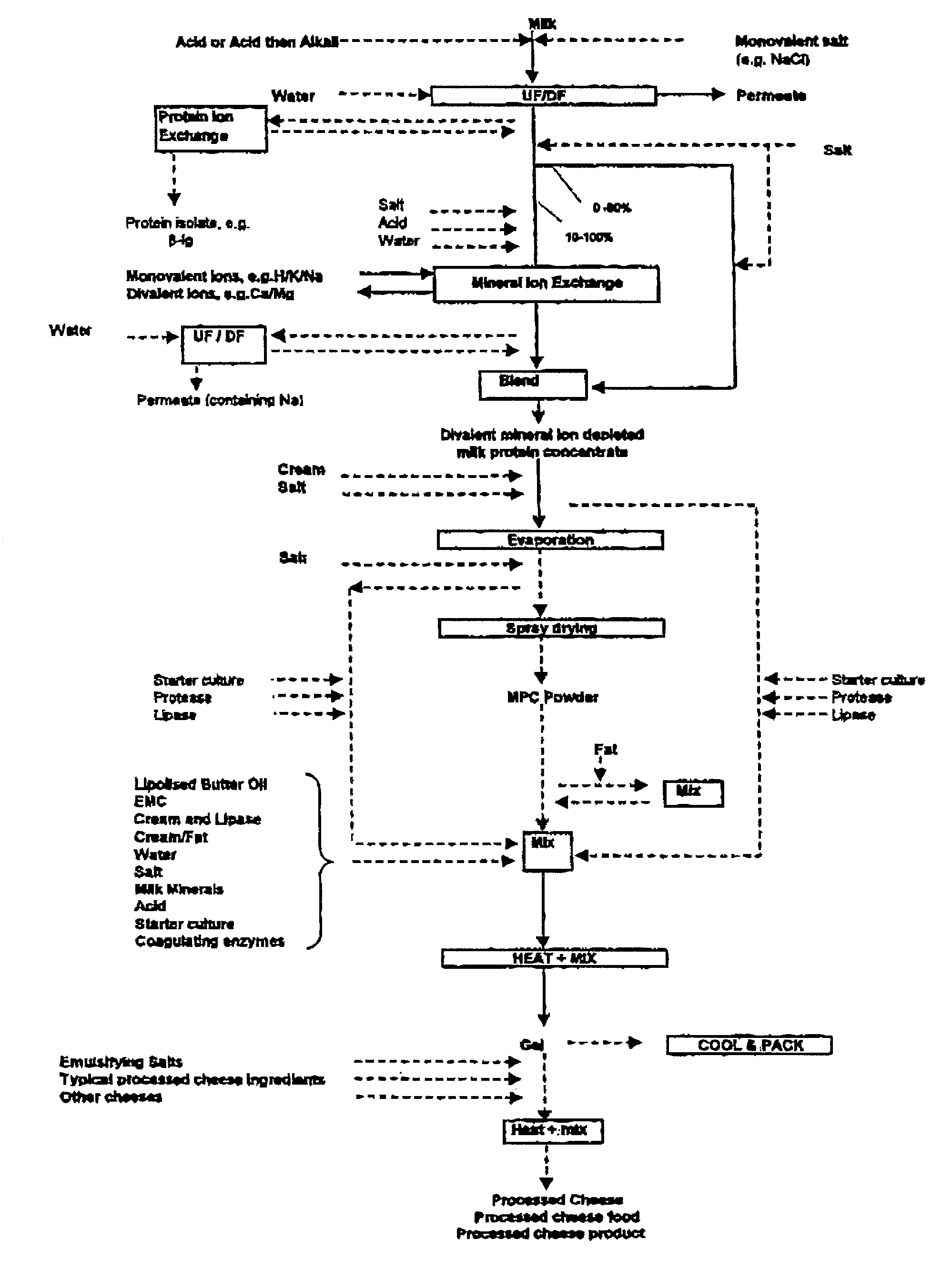Modified milk protein concentrates and their use in making gels and dairy products
a technology of milk protein and concentrate, which is applied in the field of production of cation-modified milk protein concentrate, can solve the problems of reducing the value of the product, limiting the proportion of calcium that can be removed during the ultrafiltration of milk, and affecting the ultrafiltration flux ra
- Summary
- Abstract
- Description
- Claims
- Application Information
AI Technical Summary
Benefits of technology
Problems solved by technology
Method used
Image
Examples
example 1
Preparation of Modified MPC Powders of this Invention
[0070]Fresh whole milk was received and cream was removed by separation at ≦5° C. to produce skim milk. The skim milk was pasteurised by standard procedures, cooled to 10° C., and processed by UF to a VCF of 3 in a system containing Koch™ S4 HFK 131 type membranes with a molecular weight cut off of 10,000. Diafiltration was then applied and continued until the protein content of the MPC solution constituted 85% of the total solids. A portion of the MPC solution was introduced into an ion exchange column containing food approved AMBERLITE™ SRILNa, a strong acid cation exchange resin, with a total exchange capacity of 2 equivalents / L of sodium.
[0071]Approximately 70 L of sodium charged resin was loaded into the 140-liter stainless steel vessel, creating a resin bed height of 55 cm. The MPC solution was treated in the ion exchange column at a flow rate of 133 kg / hr, and collected in a storage vessel. On completion of the ion exchange...
example 2
Comparison of the Gelation Characteristics of Modified MPCs of this Invention with MPCs Manufactured by the Process Implied by Arnaud in EP16292.
Manufacture of Arnaud Powders
[0074]Whole milk was received and cream removed by separation to produce skim milk. Approximately 1150 L of the skim milk was filtered by UF at 10° C. (using Koch HFK 131 membranes with a molecular weight cut off of 10,000), using a VCF of 4.0, to produce an MPG solution. This MPC solution was diluted with deionised water to reduce the total solids content to ˜10%, and then adjusted to pH 5.9 using 3% lactic acid before treatment in an ion exchange column containing 150 L of cation exchange resin (Rohm and Haas AMBERLITE™ SR1L Na) charged with sodium ions.
[0075]Approximately 85 kg of the cream at 55° C. was adjusted to pH 5.9 with 3% lactic acid and passed through a Pharmacia ion exchange column containing ˜5 L of food grade cation exchange resin (Rohm and Haas AMBERLITE™ SR1L Na) charged with sodium ions.
[0076]...
example 3
Preparation of Cheddar-like Cheese
[0096]Pasteurized whole milk was adjusted to a temperature of 50° C. and concentrated by ultrafiltration to a VCF of 4.65, using a UF / DF system containing membranes with a 10,000 molecular weight cutoff. After filtration, 1.225 kg of MPC solution, at 50° C., was added to a twin screw, process cheese cooker with a capacity of 5 kg (Model CC10, Blentech Corporation, Rohnert Park, Calif.). The rotational speed of the twin screws was set to 50 rpm and 57 g of sodium chloride added. The product was mixed for about 2 minutes and 1.35 kg of plastic cream (80% fat) at ≈8° C. was added to the mixture. The agitation fully incorporated the plastic cream into the mixture within 2 minutes. When the plastic cream was filly blended into the mixture, 0.8 kg of the modified MPC85 powder (produced by the procedure detailed in example 1, to have a protein content of 85% on a dry basis and a calcium content of 378 mmol / kg total protein, ie 33% deplete) and 125 g of lac...
PUM
 Login to View More
Login to View More Abstract
Description
Claims
Application Information
 Login to View More
Login to View More - R&D
- Intellectual Property
- Life Sciences
- Materials
- Tech Scout
- Unparalleled Data Quality
- Higher Quality Content
- 60% Fewer Hallucinations
Browse by: Latest US Patents, China's latest patents, Technical Efficacy Thesaurus, Application Domain, Technology Topic, Popular Technical Reports.
© 2025 PatSnap. All rights reserved.Legal|Privacy policy|Modern Slavery Act Transparency Statement|Sitemap|About US| Contact US: help@patsnap.com

